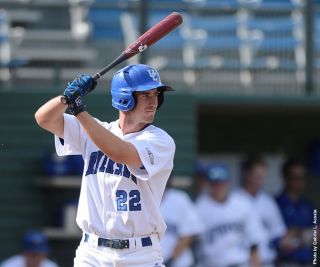Teamwork
How to Build a Better Batter
Training in visual skills scores big on the baseball field.
Posted February 18, 2014
“I’ve spend my career studying plasticity in the visual system,” says University of California Riverside (UCR) psychology professor Aaron Seitz. He has always wanted to apply his vision research in a way that directly benefits people, so he created a video game that taps into the adult brain’s inherent plasticity, or capacity for change. The game, which he calls ULTIMEYES, trains visual skills; it requires the player to target patches of varying spatial frequency and orientation—the same sort of visual targeting batters use when they track a baseball.

Postdoctoral fellow Jenni Deveau and psychologist Daniel Ozer worked with Seitz to test the game’s effects in a practical way—on the baseball diamond. Before the start of the 2013 NCAA Division 1 baseball season, the researchers assigned 19 UCR baseball players to 30 25-minute training sessions using the game. Another 18 team members received no training.
Improvements in two kinds of visual skills were measured in those players who trained with the game:
- An average of 31 percent improvement in binocular visual acuity at 20 feet (Visual acuity is the ability to see detail and small objects at a distance, i. e the ability eye charts measure.)
- Greater sensitivity to contrasts in light (differentiating dark, light, and shades in between where one object or area contrasts with another in brightness)
After training, the UCR players reported “seeing the ball much better,” “greater peripheral vision,” “easy to see further,” “able to distinguish lower contrasting things,” “eyes feel stronger, they don’t get tired as much,” and so on.
Along with these changes in visual ability came a statistically significant change in on-field performance. The strike-outs of trained players decreased from 22.1% to 17.7% of plate appearances, a statistically significant reduction. No similar reduction occurred anywhere else in the Big West Conference. The UCR team also scored 41 more runs than predicted, even when taking into account the improvements generally achieved over the course of a season. UCR’s year-over-year improvements were at least three times greater than the rest of the league in batting average, slugging percentage, on-base percentage, walks, and strikeouts.

UCR head baseball coach Doug Smith.
Baseball is a very visual game, and the ability of batters to tell the differences between pitches and ball speeds is critical, said UCR head baseball coach Doug Smith in explaining why he allowed his players to participate in the research. “I thought if this would help our players see more clearly we would have a chance to make a big breakthrough,” he said.
Baseball players typically have excellent vision, so the extent of improvement surprised the researchers. After completing the vision-training program, some players’ vision improved to 20/7.5. This means that what the average person can read at 7.5 feet away these players can read at a distance of 20 feet. Normal vision using the Snellen eye chart is 20/20.
Coach Smith was surprised, too. “I didn’t think we would see as much of an improvement as we did,” he said. “Our guys stopped swinging at some pitches and started hitting at others.”

Brain-training research psychologist Jenni Deveau, U-Cal Riverside.
The UCR researchers said it’s too early to know if changes in vision were solely responsible for the improved play or if brain training combined with unmeasured factors improved batting performance. Still, they see many applications for their work. “We use vision for many daily tasks, including driving, watching TV, or reading,” said Jenni Deveau, lead author of the research report that appears in this week's Current Biology. “This type of vision training can help improve not only sports performance, but many of these activities in non-athletes as well.”
“The exciting thing,” said Seitz, “is that this type of training has potential to help pretty much everyone in the world. For example, one application that we are exploring is that many people who start to need reading glasses in their late 30s, early 40s can get by without glasses for longer, in some cases permanently, by using this program. Likewise, I currently have a grant from the NIH to treat individuals with vision problems such as amblyopia, age-related macular degeneration, and cataracts with the program.
“In other realms we have worked with the Los Angeles Police Department (helicopter pilots and their forensics division) and are starting a collaboration with the Riverside Police Department to address specialized vision needs of these populations. Definitely other athletes, military personnel, [and others] can all get benefit.
“It is really exciting to have created something that has a lot of potential for a lot of different individuals. Vision is really paramount to so many aspects of what we do, and improving vision can thus have profound impact to our lives.”
Caption: Brain-training research psychologist Jenni Deveau, U-Cal Riverside.
For More Information:
Jenni Deveau, Daniel J. Ozer, and Aaron R. Seitz. Improved vision and on-field performance in baseball through perceptual learning. Current Biology, Feb. 17, 2014, R146.




